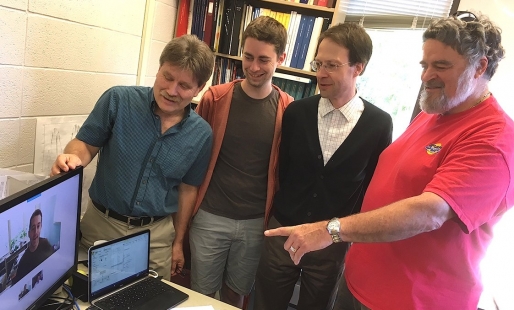Cornell team creates tool to detect molecules in the cosmos
September 22nd, 2016
Sept. 22, 2016

Gordon Stacey, left, Nicholas Cothard, Thomas Nikola and George Gull speak with Steve Parshley on the video screen during an instrument team teleconference.
To find the detailed building blocks of life in the cosmos, a new, third-generation instrument will be placed on NASA’s SOFIA – the airliner-based Stratospheric Observatory for Infrared Astronomy.
Professor Gordon Stacey will lead a Cornell team of researchers and students to develop the cryogenic scanning Fabry-Perot interferometers, a key tool for detecting distant molecules.
The team will develop and build the interferometers to be part of the High Resolution Mid-InfrarEd Spectrometer, or HIRMES. This instrument will detect neutral atomic oxygen, water, hydrogen and deuterated (heavy) hydrogen molecules at infrared wavelengths between 28 and 112 microns – one-millionth of a meter.
Detecting these wavelengths is key to learning how water vapor, ice and oxygen combine with dust to form planets, according to NASA. First light for HIRMES aboard SOFIA is slated for spring 2019.
“These very high spectral-resolution Fabry-Perot interferometers are one of the two key technological challenges for the successful operation of HIRMES on SOFIA,” said Stacey, professor of astronomy.
